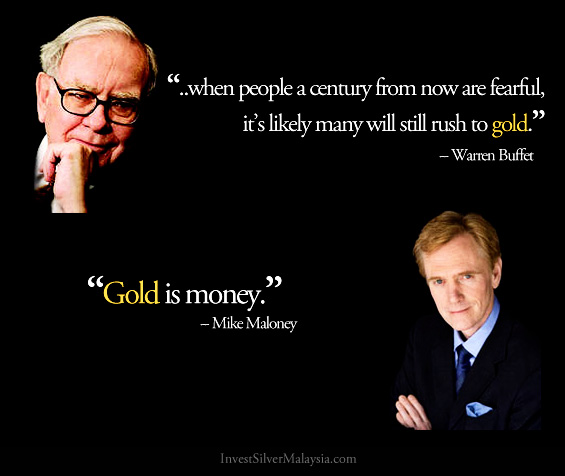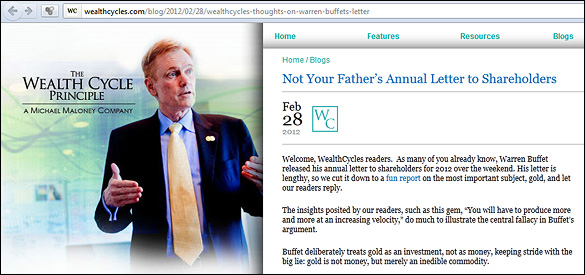“Gold is for the Fearful”, Buffet; Maloney Disagreed
Warren Buffet has recently published his annual letter to his Berkshire Hathaway‘s shareholders.

^ Buffer thinks Gold is for the fearful; Maloney says otherwise.
In his letter, he wrote his comment about Gold, which he refers as a short term “bandwagon” for fearful investors. Maloney however, on the other hand critised Buffet’s ways of comparing gold as an investment.
Warren Buffett’s Letters to Berkshire Shareholders 2011
Quoted from Page 17 to Page 18:
The second major category of investments involves assets that will never produce anything, but that are purchased in the buyer’s hope that someone else – who also knows that the assets will be forever unproductive – will pay more for them in the future. Tulips, of all things, briefly became a favorite of such buyers in the 17th century.
This type of investment requires an expanding pool of buyers, who, in turn, are enticed because they believe the buying pool will expand still further. Owners are not inspired by what the asset itself can produce – it will remain lifeless forever – but rather by the belief that others will desire it even more avidly in the future.
The major asset in this category is gold, currently a huge favorite of investors who fear almost all other assets, especially paper money (of whose value, as noted, they are right to be fearful). Gold, however, has two significant shortcomings, being neither of much use nor procreative. True, gold has some industrial and decorative utility, but the demand for these purposes is both limited and incapable of soaking up new production. Meanwhile, if you own one ounce of gold for an eternity, you will still own one ounce at its end.
What motivates most gold purchasers is their belief that the ranks of the fearful will grow. During the past decade that belief has proved correct. Beyond that, the rising price has on its own generated additional buying enthusiasm, attracting purchasers who see the rise as validating an investment thesis. As “bandwagon” investors join any party, they create their own truth – for a while.
Over the past 15 years, both Internet stocks and houses have demonstrated the extraordinary excesses that can be created by combining an initially sensible thesis with well-publicized rising prices. In these bubbles, an army of originally skeptical investors succumbed to the “proof” delivered by the market, and the pool of buyers – for a time – expanded sufficiently to keep the bandwagon rolling. But bubbles blown large enough inevitably pop. And then the old proverb is confirmed once again: “What the wise man does in the beginning, the fool does in the end.”
Today the world’s gold stock is about 170,000 metric tons. If all of this gold were melded together, it would form a cube of about 68 feet per side. (Picture it fitting comfortably within a baseball infield.) At $1,750 per ounce – gold’s price as I write this – its value would be $9.6 trillion. Call this cube pile A.
Let’s now create a pile B costing an equal amount. For that, we could buy all U.S. cropland (400 million acres with output of about $200 billion annually), plus 16 Exxon Mobils (the world’s most profitable company, one earning more than $40 billion annually). After these purchases, we would have about $1 trillion left over for walking-around money (no sense feeling strapped after this buying binge). Can you imagine an investor with $9.6 trillion selecting pile A over pile B?
Beyond the staggering valuation given the existing stock of gold, current prices make today’s annual production of gold command about $160 billion. Buyers – whether jewelry and industrial users, frightened individuals, or speculators – must continually absorb this additional supply to merely maintain an equilibrium at present prices.
A century from now the 400 million acres of farmland will have produced staggering amounts of corn, wheat, cotton, and other crops – and will continue to produce that valuable bounty, whatever the currency may be. Exxon Mobil will probably have delivered trillions of dollars in dividends to its owners and will also hold assets worth many more trillions (and, remember, you get 16 Exxons). The 170,000 tons of gold will be unchanged in size and still incapable of producing anything. You can fondle the cube, but it will not respond.
Admittedly, when people a century from now are fearful, it’s likely many will still rush to gold. I’m confident, however, that the $9.6 trillion current valuation of pile A will compound over the century at a rate far inferior to that achieved by pile B.
Not Your Father’s Annual Letter to Shareholders
That was the title Micheal Maloney erected in his WealthCycles blog, responding to Warren Buffet’s letter.
“Honestly, there is a party going on!”

^ Mike Maloney regarded the letter as “Not Your Father’s Annual Letter to Shareholders”
Gold is money
Maloney argued that Buffet’s idea to treats gold as an investment and not as money as a big lie.
“We are not surprised Warren continues to make the statists’ argument, as he will be the biggest individual nominal loser when the currency system collapses. Instead of doing what is morally right, he went all in with Goldman Sachs, Wells Fargo, and Bank of America in big-currency pacts that make one blush. Warren Buffet ignores his dad’s legacy. Howard Buffet, an honorable Congressman, stressed the invariable relationship between money and freedom; a real man, who stood for real people.”, wrote Maloney.
Paper Systems End in Collapse
So what did Warren Buffet’s dad said?
“So far as I can discover, paper money systems have always wound up with collapse and economic chaos.”
Click to read Horward Buffet’s 1948 “Human Freedom Rests on Gold Redeemable Money”.
Berkshire Shareholders’ Letter
The letter is available publically and you can download it from Berkshire official website at this link: http://www.berkshirehathaway.com/letters/letters.html.
Alternatively, you can download the copy hosted at our server by clicking here.







There's 0 Comment So Far